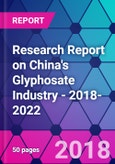There is a stable increase in global transgenic crop cultivation area in recent years. In 2016, the transgenic crop cultivation area was 190 million hectares, increasing by 3.0% YOY. Correspondingly, the global sales of glyphosate exceeded USD 5 billion in 2017. China is a major glyphosate exporter in the world. Over 80% of China-made glyphosate is exported to account for over 60% of the global supply. The output of glyphosate in China increased from 316,000 tons in 2010 to about 505,000 tons in 2017. In 2017, China exported over 300,000 tons of glyphosate technical, which satisfied more than half of the global glyphosate demand.
At present, the glyphosate synthesis process is mature, and the technical barriers in the industry are low. However, the Chinese government is tightening the environmental supervision over the glyphosate industry in recent years because it is difficult to deal with the large amount of wastewater generated in the glyphosate production process. Many small and medium-sized enterprises quit owing to the high costs of four-round environmental supervision and continued market downturn. In the past two years, the increasing industry concentration led to integrated factories of raw materials and products that have cost and resource advantages as well as non-integrated factories that have certain scale advantage. The competition in the industry is becoming increasingly fierce.
The strengthened enforcement of environmental protection laws has not only increased the production costs of glyphosate enterprises but also tightened the supply and increased the price of glycine, the upstream raw material of glyphosate. Driven by higher costs of raw materials and production, the market price of glyphosate grows higher but the profitability becomes lower. It should be noted that the global glyphosate demand will continue to grow in the future as the continued expansion of transgenic crop cultivation area broadens the market space of glyphosate. In addition, China has forbidden the use of highly toxic herbicides such as paraquat but the transgenic crop cultivation area is expanding. Therefore, the domestic glyphosate demand will also continue to grow.
Topics Covered:
- Bases for transgenic crop cultivation
- Concept and application of glyphosate
- Development environment of China's glyphosate industry
- Competition in China's glyphosate industry
- Major glyphosate manufacturers in China
- Factors influencing development of China's glyphosate industry
- Forecast on supply and demand in China's glyphosate industry
Table of Contents
Samples

LOADING...
Companies Mentioned
- Hubei Taisheng Chemical Co., Ltd.
- Fuhua Tongda Agro-chemical Technology Co., Ltd.
- Zhejiang Xinan Chemical Industry Group Co., Ltd.
- Zhejiang Jinfanda Biochemical Co., Ltd.
- Nantong Jiangshan Agrochemical & Chemicals Co., Ltd.
- Shandong Weifang Rainbow Chemical Co., Ltd.
- Jiangsu Good Harvest-Weien Agrochemical Co., Ltd.
- Jiangsu Yangnong Chemical Co., Ltd.
- CAC Nantong Chemical Co., Ltd.
- Jingma Chemicals Co., Ltd.
Methodology
Background research defines the range of products and industries, which proposes the key points of the research. Proper classification will help clients understand the industry and products in the report.
Secondhand material research is a necessary way to push the project into fast progress. The analyst always chooses the data source carefully. Most secondhand data they quote is sourced from an authority in a specific industry or public data source from governments, industrial associations, etc. For some new or niche fields, they also "double-check" data sources and logics before they show them to clients.
Primary research is the key to solve questions, which largely influence the research outputs. The analyst may use methods like mathematics, logical reasoning, scenario thinking, to confirm key data and make the data credible.
The data model is an important analysis method. Calculating through data models with different factors weights can guarantee the outputs objective.
The analyst optimizes the following methods and steps in executing research projects and also forms many special information gathering and processing methods.
1. Analyze the life cycle of the industry to understand the development phase and space.
2. Grasp the key indexes evaluating the market to position clients in the market and formulate development plans
3. Economic, political, social and cultural factors
4. Competitors like a mirror that reflects the overall market and also market differences.
5. Inside and outside the industry, upstream and downstream of the industry chain, show inner competitions
6. Proper estimation of the future is good guidance for strategic planning.

LOADING...








